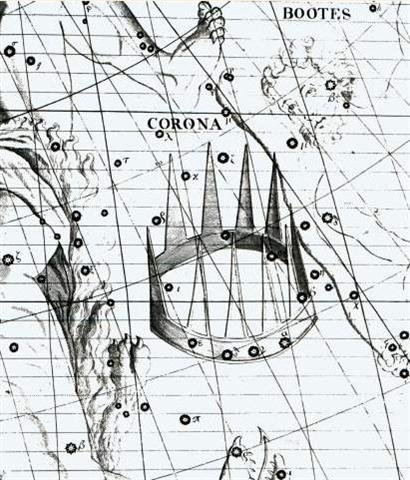1. Although my astronomy book has only one star
for Corona Borealis
in its list, Gemma (α),
there are many with Greek letters in the constellation:

7 of these stars can be
imagined as forming a kind of diadem. But Flamsteed (I have copied
the picture from Ian Ridpath's site) has a crown with
10 'tines':

There are 4 stars (α,
γ, δ, ε) in front, with β evidently at the beginning of the front
side.
In the G text Gemma is at a mama glyph with 5 'wave chevrons':
 |
 |
 |
 |
 |
|
Ga6-29 |
Ga7-1
(171) |
Ga7-2 |
Ga7-3
(*237) |
Ga7-4 |
|
φ² Lupi
(233.5), Pherkad (233.6), υ Lupi (233.9), Alkalurops
(234.1) |
|
|
γ Lupi
(236.6),
Gemma,
Zuben Elakrab (236.7). ω Lupi (237.3) |
ψ¹
Lupi (237.7) |
|
November
10 (314) |
11 |
12 |
13 |
14 |
Number 237 is one
more than half 472 and we know that in glyph 237 someone is 'finished':
 |
 |
|
Gb1-6 (*300) |
Gb1-7 (237) |
| Mama
1. To chew. 2. To mouth-feed (arch.)
he-mama i te vai tôa koia ko te tiapito kiroto ki te
haha o te poki, she mouth-feeds the child with
sugarcane juice together with tiapito juice. 3. A
sea mollusc (with an eight-horned shell). Vanaga.
1. To leak, to ooze, (maamaa).
P Pau., Mgv., Ta.: mama, id. 2. To chew. P Mgv.,
Mq., Ta.: mama, id. 3. Light not heavy, (maamaa).
P Mgv., Ta.: mama, id. 4. A limpet (Chiton
magnificus). Mgv., Mq., mama, a shellfish. 5.
To open the mouth; hakamama, to yawn, to gape, to
be ajar. Pau.: hamama, to open. Mgv.: akamama,
to burst open. Ta.: haamama, to open. Mq.:
haámama, to open the mouth. 6. Ta.: mama-orero,
conclusion of a council. Ha.: mama,
to finish, to have done with a
thing. Churchill. |
In
front of the mama - as if growing out from it - there is
a 'fictitious' haga with a mea ke at the
top. The arrangement seems to be a reversal of the
sign of 'going inside' in Ga1-23 (149 days earlier):
 |
 |
 |
 |
 |
|
Ga1-22 |
Ga1-23 (496) |
Ga1-24
(25) |
Ga1-25 (*90) |
Ga1-26 |
|
γ Leporis
(494.9) |
Saiph
(495.5), ζ Leporis (495.6) |
Wezn
(496.6), δ Leporis (496.7), Betelgeuze (497.3) |
η Leporis (498.0), Praja-pāti, Menkalinan, Mahashim, and
γ Columbae (498.3) |
η Columbae
(498.7), μ Orionis (499.3) |
|
June 16 |
17 (168) |
18 |
19 |
6h (499.3) |
|
June
18 (169) |
146 |
November 12 (316) |
48 |
168 |
|
148 |
216 |
However,
instead of counting 148 + 216 = 364 we maybe should rather count
according to the Pachamama tresses:
|
May
12 (132) |
35 |
June
17 (168) |
148 |
November 13 (317) |
213 |
June
15 (531) |
|
185 |
½ |
½ |
214 |
|
counting the tresses from left to right: |
|
1 |
29 |
8 |
27 |
|
2 |
30.5 |
9 |
26 |
|
3 |
31 |
10 |
26.5 |
|
4 |
34 |
11 |
26.5 |
|
5 |
31 |
12 |
26.5 |
|
6 |
30 |
13 |
27 |
|
7 |
29 |
14 |
26 |
|
sum |
214.5 |
sum |
185.5 |
|
total = 400 |
 |
 |
 |
 |
 |
|
Ga1-17 |
Ga1-18 |
Ga1-19 (492) |
Ga1-20 (**465) |
Ga1-21 |
|
Bellatrix, Saif
al Jabbar (489.7), Elnath (489.9)
|
Nihal (490.7), Mintaka (491.4) |
ε Columbae (491.6), Arneb (492.0), Heka
(492.2) |
Hatysa (492.5), Alnilam (492.7), Heavenly
Gate (493.0) |
Alnitak, Phakt (Phaet), (493.7) |
|
June 11 |
12 |
13 (164) |
14 |
531 - 365 = 166 |
|








